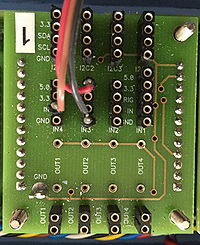Kart/sensor board
|
The sensor board provides different I/Os to the system. The schematics provides detailed information about it.
Inputs and outputs
End of turn switch
The end of turn switch is located in the I/O board's middle row. It is the 4-pin connector closest to the 5-pin connector. The switch cable is to be connected as:
cable pin green 5 V power supply yellow input
The input has a pull-down resistor. Closing the switch brings a logic '1'.
Hall sensors
The Hall sensors connectors are located in the I/O board's middle row, on the side opposite to the 5-pin connector. The sensor cable is to be connected as:
cable pin red 5 V power supply brown sensor signal black ground
Ultrasound ranger
The ultrasound ranger connectors are located on the side of the I/O board's middle row. It is the single 5-pin connector. The sensor cable is to be connected as:
cable pin red 5 V power supply yellow measurement start (trig) green distance signal (echo, in) black ground
Proximity sensors
The proximity sensor connectors are located in the I/O board's side row.
The sensor cable is to be connected as:
cable pin orange 3.3 V power supply yellow SDA green SCL blue ground
LED outputs
The board has 4 LED outputs which can also be used for other purposes, such as buzzers.
The outputs have a common power supply, 2 resistor mount holes and a 2-pin LED connector located on the I/O board's bottom row.
The power supply is connected directly to the 12 V battery packs. The resistor is connected between the power supply and the LED. The LED is connected between the resistor and the switch to the ground.
FPGA design
One or two Hall sensors are used to track the distance driven by the kart. An ultrasound ranger can detect if there is an obstacle at the front of the kart.
To begin with, the design environment has to be downloaded.
It comprises the sensorsInterface block which contains the provided I2C bus interface,
an empty hallCounters block
and an empty ultrasoundRanger block which are to be designed.
Hall sensor
The hall sensor has a Schmitt-trigger output. This means that it has to "see" a north and then a south magnetic pole in order to switch its output.
The block receives a hallPulses signal array, one per hall pulse sensor.
For each of these inputs, it requires a counter.
The counter values are concatenated to build the position output.
The counters shall increment at each Hall signal pulse or, twice as fast, at each square signal edge.
Ultrasound ranger
The ultrasound ranger receives a trigger signal, startMeasure, and sends an ultrasound pulse.
Once the pulse is sent, the sensor drives distancePulse to '1' as long as it hasn't received any echo.
The circuit has to count the length of the sequence in terms of clock pulses and returns the value on distance.
Test pins
The basic sensor design leaves 5 free pins. Pins 13 to 15 are foreseen for test outputs. Pins 10 to 11 are foreseen for test outputs with a divider by 2 for pulses.
